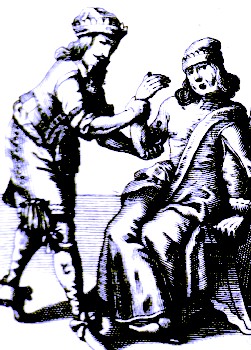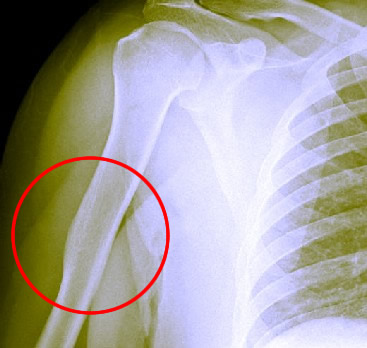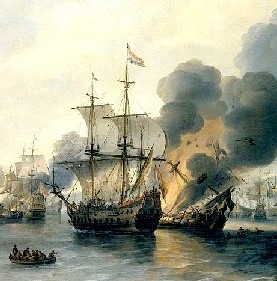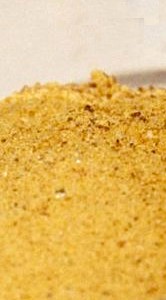
Fractures Page Menu: 1 2 3 4 5 6 7 8 9 10 11 12 <<First
Fracture Treatment During the Golden Age of Piracy, Page 12
Fracture Healing Time
"It may be asked, at what Distance of Time it will be proper to open a Fracture. To which I answer, not until a Callus has knit the Ends of a Bone, which, for a common Computation, may be in about three Weeks." (John Atkins, The Navy Surgeon, p. 50)

Artist: Jonas Arnold Delineavi
Checking a Fractured Arm From
Armamentarium Chirurgicum Bipartitum,
by Johannes Scultetus, p. 113 (1666)
The time it takes for a fracture to heal depends on many factors including the type of wound, the patient's diet and ability to let the bone lie still and heal. While Atkins suggests a minimum of three weeks for fracture healing to occur, Richard Wiseman notes that one case he treated took about eight weeks to mend.1
Hippocrates book suggests average healing times for fractures based on the type of bone that fractured, although he admits that other factors are important as well. "The bones of the fore-arm generally get consolidated in thirty days altogether; but there is nothing precise in this matter, for one constitution differs from another."2 He finds the bone of the upper arm is "generally consolidated in forty days."3 "The bones of the leg get consolidated in forty days, if properly treated."4
So the general projection for limb bone regeneration during the golden age of piracy is 3 - 8 weeks, with most fractures healing in 4 to 5 weeks. Modern estimates suggest basic limb function in a healthy patient can usually be regained in about 4 -8 weeks5, showing that old Hippocrates knew a thing or two about fracture healing. Of course, today we are able to examine what's going on inside leading experts to say that full healing of a fracture is a bit more lengthy. "The whole process can take up to 18 months, but in adults the strength of the healing bone is usually 80% of normal by 3 months after the injury."6
1 Richard Wiseman, Of Wounds, Severall Chirurgicall Treatises, p. 427; 2 Hippocrates, Hippocratic Writings, Translated and Edited by Francis Adams, p. 77; 3 Hippocrates, p. 78; 4 Hippocrates, p. 82; 5 This varies widely, , but see How Long Does It Take For a Fracture to Heal, ABCNews.com, written 7/1/09 and gathered 5/16/14 and How Long Will It Take to Heal a Broken Leg, response by Dr., Phillip J. Kim, healthtap.com, gathered 5/16/14; 6 Bone Fracture, wikipedia.com, gathered 5/16/14
Are Fractures Stronger Where the Bone has Healed?
You occasionally hear that bones are stronger where they have been fractured and healed. This

Image: Nevit Dilmen
A Healed Humerus Bone. Other Than the Slight
Deformity,The Bone Looks Fairly Uniform
goes back to the golden age of the pirates (and before.) Writing in the late 16th century, Ambroise Paré said that the healed fracture callus "is so hardened in time, that the bone thereafter in the broken part is seene to be more firme and hard than it is in any other"1. Writing in the late 17th century, Richard Wiseman cites Hippocrates, noting that "though it [the callus] be not Bone, it is so hard, saith he, that if the Member hap again to be broke, potiús in alia parte frangitur, quám ubi Callus est genitus, it breaks any where rather than in the Callus."2
In fact, they had it wrong. While the healed site may temporarily become stronger as the new callus is built up while the surrounding bone loses a little strength because the limb isn't being used, over the long haul it isn't stronger. Dr. Terry D. Amaral, director of pediatric orthopedic surgery at Montefiore Medical Center in the Bronx notes that "in studies in which healed bones were subjected to bending and twisting forces, the repaired bones were capable of breaking anywhere, including the fracture site."3
1 Ambroise Paré, The Apologie and Treatise of Ambroise Paré, p. 64; 2 Richard Wiseman, Of Wounds, Severall Chirurgicall Treatises, p. 470; 3 Anahad O'Conner, "The Claim: After Being Broken, Bones Can Become Even Stronger", New York Times website, Published: October 18, 2010, gathered 5/16/14
Fracture Case Study
Multiple case studies are cited in the various surgeon's manuals from the golden age of piracy. Many of these have interesting features, so the last section will highlight one as a way of

Artist: Willem van Diest
reviewing some of the concepts discussed. I have inserted paragraph breaks and notes where I thought they would be helpful, but otherwise it is as it appeared in Richard Wiseman's book.
A Commander at Sea, valiantly fighting in the midst of the Enemie's Fleet, had his Leg fractured by the fall of his Mizzen top-mast, it breaking his Leg transverse near the Ancle, the edge of the Bone thrusting out through the Skin.
He not suffering [wanting] the Bone then presently to be set while it was warm [recently fractured], afterwards, when it was swelled and stiff, it did not yield to Extension [restoration to the normal position by pulling], but became painful and inflamed.
After some few days he was brought to London, and I was sent to him. He was of an ill Habit of body [overweight], subject to the Gout and Dysenterie; and the Fracture being accompanied with great Defluxion [discharge from inflammation] was not in a condition to admit of Extension.
_Wellcome_M0002609s.jpg)
Gabriel Fallopio 16th c. Anatomist & Physician
Therefore, according to Fallopius [Gabriel Fallopio (1523-62) anatomist and surgeon] and Hippocrates, before cited by me in the Treatise, I proposed to his Chirurgeon to proceed by Lenients [soothing medicines], to mitigate Pain, Inflammation &c. and by Bandage to hinder Defluxion. Which we did; and his Chirurgeon continued that method a few days, by which the Accidents were remitted.
When we met again, finding the Patient in ease, we took off the Dressings, and agreed to make Extension, and reduce the Fracture [align the broken ends of the bone]. The Patient was of a dry tough Body [from a humoral sense, probably Choleric], and the Member yielded difficultly to the Stretch: upon which consideration we satisfied our selves with a moderate Extension, doubting that upon a more forcible one ill Accidents might follow, (as an Inflammation presently did.)
We drest it up as a compound Fracture: and after some days dressing a Callus thrust forth, and united the Bones.

Photo: Nina Aldin Thune
Powdered Gum Myrrh
That Callus being confirmed and dried, we hasten'd the Exfoliation [casting off outer surfaces of bone] of the foul Bone by a little Ægyptiacum [detergent ointment containing verdigris (copper acetates), honey and vinegar] and pulv. myrrhæ [resinous gum Myrhh, used as a tincture] dissolved in spir. vini [spirit of wine], applied hot upon an armed Probe. Thus the Bone was exfoliated, and the Ulcer cured by the ordinary Intentions in such cases.
Yet the inward leaning of the Bone continued a weakness in the Member a long time, as is usual where the Fracture hath not been timely or well reduced. To remedy this, I caused a Bar of Steel to be fixed in his Shoe with joints, and by a Bracer of Cloath to be laced on, or tied with Ribbons on the outside of the Leg; by which it was marvellously strengthened.1
Matthias Gottfried Purmann closed one of his case studies by telling the surgeon that he was "not to despair of a Cure, how dangerous soever the Patient’s condition is, for Nature works Wonders, when assisted by Art and Industry, as in the case before us, tho’ the Part was extreamly weakned by the loss of so much Flesh and many Splinters, and the Bones bruised and broken almost into an hundred pieces, yet the Patient came to be perfectly well again. By which you may perceive what the Sanative [healing] Constitution of the Patient, and the Care and Diligence of the Chirurgeon is able to perform."2
1 Richard Wiseman, Of Wounds, Severall Chirurgicall Treatises, p. 475; 2 Matthias Gottfried Purmann, Churgia Curiosa, p. 215

